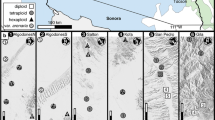Abstract
TheAntennaria neodioica polyploid agamic complex is a polymorphic species occurring across North America mainly north of the terminal margin of the Wisconsin glacier. This taxonomically difficult group has recently been treated as consisting of the four subspeciesA. neodioica subsp.canadensis, subsp.howellii, subsp.neodioica, and subsp.petaloidea. TheA. neodioica agamic complex has been considered of hybrid origin with several sexual diploid species constituting its parentage. Crosses were made among five sexual diploid species ofAntennaria, morphologically similar toA. neodioica s.l., in an attempt to discover its origins. Representative specimens of the five diploid species,A. neodioica s. l., and the synthetic interspecific F1 hybrids were subjected to various analyses including PCA, cluster (UPGMA), and discriminant analyses. Results suggest that theA. neodioica complex is of multiple hybrid origin involving the four diploid speciesA. neglecta, A. plantaginifolia, A. racemosa, andA. virginica. BecauseA. neodioica is the result of diverse origin it is more desirable to consider the agamic complex as a separate, distinct species from its sexual diploid relatives. Several morphological characters in the diploid species were determined to be polygenically inherited.
Similar content being viewed by others
References
Alexander, M. P., 1980: A versatile stain for pollen, fungi, yeast, and bacteria. — Stain Technol.55, 13–18.
Bachmann, K., Chambers, K., Price, H. J., Konig, A., 1982: Four additive genes determining pappus part numbers inMicroseris annual hybrid C34 (Asteraceae/Lactuceae). — Pl. Syst. Evol.141, 123–141.
Bayer, R. J., 1984a: Chromosome numbers and taxonomic notes for North American species ofAntennaria (Asteraceae: Inuleae). — Syst. Bot.9, 74–83.
, 1984b: Evolutionary investigations inAntennaria Gaertner (Asteraceae: Inuleae). — Ph.D. dissertation, Ohio State Univ., Columbus.
,Stebbins, G. L., 1981: Chromosome numbers of North American species ofAntennaria Gaertner (Asteraceae: Inuleae). — Amer. J. Bot.68, 1342–1349.
,, 1982: A revised classification ofAntennaria (Asteraceae: Inuleae) of the eastern United States. — Syst. Bot.7, 300–313.
,, 1983: Distribution of sexual and apomictic populations ofAntennaria parlinii. — Evolution37, 555–561.
Cronquist, A. J., 1945: Notes on theCompositae of the northeastern United States. I.Inuleae. — Rhodora47, 182–184.
Dixon, N. J., 1981: BMDP Statistical Software. — Berkeley, California: Univer. of California Press.
Grant, V., 1981: Plant Speciation. 2nd ed. — New York: Columbia.
Harlan, J. R., Dewet, J. M. J., 1963: The compilospecies concept. — Evolution17, 497–501.
Jensen, R. J., Eshbaugh, W. H., 1976a: Numerical taxonomic studies of hybridization inQuercus. I. Populations of restricted areal distribution and low taxonomic diversity. — Syst. Bot.1, 1–9.
,, 1976b: Numerical taxonomic studies of hybridization inQuercus. II. Populations with wide areal distributions and high taxonomic diversity. — Syst. Bot.1, 10–19.
Juel, H. O., 1900: Vergleichende Untersuchungen über typische und parthenogenetische Fortpflanzung bei der GattungAntennaria. — Kongl. Svenska Vetenskaps-akad. Handl.33 (5), 1–59.
Levin, D. A., 1978: The origins of isolating mechanisms in plants. InHecht, M., Steere, W., Wallace, B., (Eds.): Evolutionary Biology II. — New York: Plenum Press.
Neff, N, A., Smith, G. R., 1979: Multivariate analysis of hybrid fishes. — Syst. Zool.28, 176–196.
Rohlf, F. J., Kishpaugh, J., Kirk, D., 1974: Numerical Taxonomy System of Multivariate Statistical Programs. — Stony Brook, New York: State Univ. of New York.
Sneath, P. H. A., Sokal, R. R., 1973: Numerical Taxonomy. — San Francisco: W. H. Freeman and Co.
Stebbins, G. L., 1932: Cytology ofAntennaria. II. Parthenogenetic species. — Bot. Gaz. (Crawfordsville)94, 322–345.
, 1935: A new species ofAntennaria from the Appalachian region. — Rhodora37, 229–237.
, 1950: Variation and Evolution in Plants. — New York: Columbia.
Whiffin, T., 1973: Analysis of a hybrid swarm betweenHeterocentron elegans andH. glandulosum (Melostomaceae). — Taxon22, 413–423.
Author information
Authors and Affiliations
Additional information
Investigations into the Evolutionary History of the Polyploid Complexes inAntennaria (Asteraceae: Inuleae). I.
Rights and permissions
About this article
Cite this article
Bayer, R.J. Investigations into the evolutionary history of the polyploid complexAntennaria neodioica (Asteraceae: Inuleae). Pl Syst Evol 150, 143–163 (1985). https://doi.org/10.1007/BF00984192
Received:
Issue Date:
DOI: https://doi.org/10.1007/BF00984192




